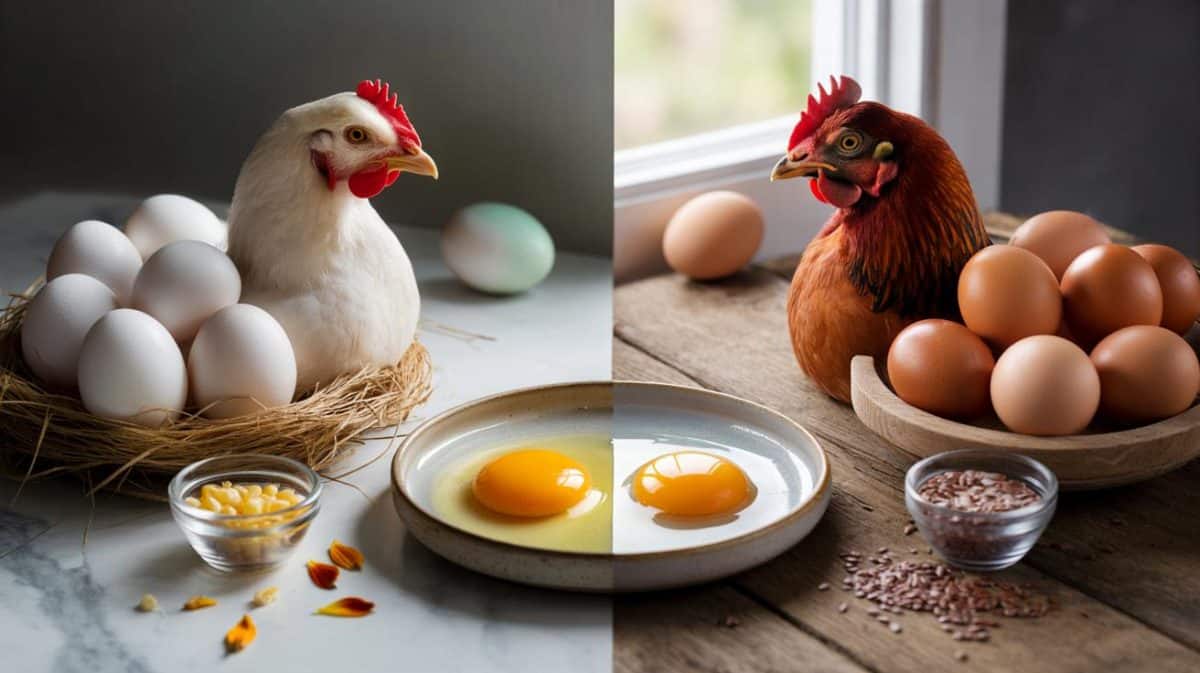Walk down any grocery aisle in the United States and you’ll notice it right away: two neatly stacked cartons, almost identical, except for one thing — the color of the shells. For decades, that simple difference has triggered hesitation, price comparisons, and a handful of myths that refuse to fade. Brown eggs often look rustic, while white shells appear clinical and processed. Marketing, nostalgia, word-of-mouth, and price tags have only deepened the confusion.
But when biology speaks, the story becomes clearer.
Shell Color: A Matter of Genetics
The color of an eggshell is set by the hen’s genetics. Breeds with white feathers and pale earlobes generally lay white eggs. Breeds with red or brown plumage tend to produce brown shells. A few heritage breeds even lay blue or green eggs. This pigmentation develops in the final stages of shell formation, and it never touches the yolk or the egg white.
Farm size, lighting, or temperature won’t turn a white egg brown. There’s no way for farmers to pigment shells artificially during formation. At the end of the day, the paint job is written in the hen’s DNA — not in marketing strategy.
Why Brown Sometimes Costs More
Many shoppers assume that a higher price must reflect better nutrition. In reality, brown eggs often cost more because the hens that lay them are usually larger breeds. Bigger birds eat more feed, require more housing space, and drive higher production costs. That gets passed down to the shelf price.
White-shell layers tend to be smaller, more efficient eaters, and easier to maintain at scale. So although the nutritional value remains almost identical, the economics—feed, labor, and energy—push brown eggs into a higher bracket in many U.S. supermarkets.
Nutrition: Almost Identical Across The Board
Crack a brown egg and a white egg side-by-side, and most nutritionists will tell you the differences are negligible. A large egg supports around six grams of high-quality protein, plus vitamins A, D, E, and B12. Egg yolks naturally supply choline, which helps support memory, mood, and metabolism.
Fats, amino acids, and caloric value remain stable across shell colors. What can change is feed.
When Feed Shapes What’s Inside
Want eggs with more omega-3s or increased vitamin D? That’s not a matter of shell shade. It’s a matter of what the farmer puts in the ration.
Hens fed flaxseed or algae may produce eggs richer in omega-3 fatty acids. When farmers add vitamin D to feed, the yolks follow suit. That’s why labels such as “Omega-3 Enriched” or “Vitamin D Enhanced” matter more than the color on the outside.
Pasture access can influence micronutrients too, though not dramatically. Some studies comparing organic and conventional eggs show modest differences, but not enough to elevate one category dramatically over the other.
Yolk Color: A Marketing Mirage
Many U.S. shoppers equate a deep orange yolk with superior nutrition. The truth? Yolk color mirrors the carotenoids in feed — often from marigold extract, corn, or alfalfa meal. Pale yolks can still carry the same protein package as their more vibrant cousins. Chefs may prefer a darker hue for plating, but the health payoff remains similar.
Shell color has no direct relationship with yolk tone.
Shopping Smart: Labels That Actually Matter
Color won’t tell you which carton is most nutritious. To shop smart:
Check the pack date or best-by date to ensure freshness.
Look for feed-based claims like omega-3 or vitamin D enrichment.
Choose pasture-raised if animal welfare matters to you.
Factor in Grade—it reflects shell stability and interior quality on inspection day, not nutrition.
Pick the egg size that fits your recipe; nutrients scale up with egg volume.
In the Kitchen: Safety Over Shell Color
Storage and handling affect food safety more than color ever will. Keep eggs in their carton in the coldest part of the refrigerator, not the door, where temperature swings occur. Wash hands and utensils after handling raw eggs, and cook until whites are firm and yolks have thickened.
A simple float test can help gauge older eggs. Fresh eggs sit neatly when poached. Slightly older ones peel better after boiling — chefs swear by this trick.
Environmental and Welfare Considerations
Today’s U.S. consumers increasingly weigh sustainability alongside nutrition. Pasture-raised systems may encourage natural behaviors, access to sunlight, and varied diets, which can shift micronutrients slightly. Indoor barns, meanwhile, can protect flocks from predators and weather stress.
It’s worth noting that brown-egg layers generally require more feed, which can nudge environmental footprints higher. Transportation costs, feed grain prices, and disease outbreaks can also swing egg prices dramatically, regardless of color.
What About Those Blue and Speckled Shells?
Heirloom breeds such as Ameraucana and Araucana lay eggs that stand out on Instagram and farmers’ market tables. Though aesthetically unique, the inside remains familiar. Your skillet won’t notice the difference.
The Budget Reality
Eggs remain one of the most affordable, nutrient-dense proteins in the American diet. At roughly 70 to 80 calories per large egg, they offer satiety, muscle-supporting amino acids, and essential vitamins, making them a smart choice for breakfast, post-workout snacks, and budget-friendly dinners.
Pair them with whole grains or vegetables, and the nutritional payoff climbs.
Bottom Line
When it comes to nutrition, shell color doesn’t win — feed does. Brown eggs aren’t automatically healthier, and white eggs aren’t inherently inferior. Price differences reflect farm economics, not quality.
So the next time you stand in front of a wall of cartons, forget the myths. Choose the eggs that match your values, budget, and meal plan. Whether white, brown, speckled, or blue, the protein payoff remains consistent — and the skillet doesn’t play favorites.

